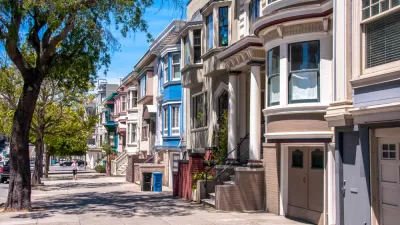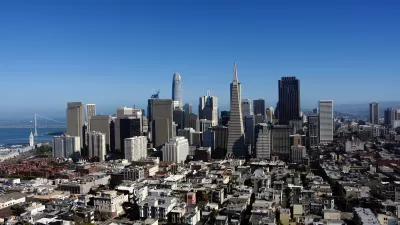When writing city plans, past planners in San Francisco got some things just right—and some very wrong.

Our readers don't need to be told that city planning is a complicated endeavor. As John King writes, the history of San Francisco's urban plans provides an illuminating example of how assumptions about urban growth can be short-sighted or naive.
King gives five examples of policies that have not panned out in the way the city expected. For example, the elevated pedestrian walkways designed in the 1960s to help pedestrians cross streets more safely have proven to deaden street life, falling out of favor with contemporary planners. Meanwhile, a law that restricted building heights near freeways in order to preserve "views" for drivers has become obsolete as planners now view high-rise towers as an appropriate way to increase density and put more housing near economic centers and transit.
As King notes, the city's 1985 Downtown Plan called for buildings that maintained the "complex architectural qualities of older San Francisco buildings," but today's planners see modern design as a potential boon to historic neighborhoods.
San Francisco plans in the 1990s also emphasized the importance of the ground floor, mandating first-floor residential units and retail. While ground-floor retail remains an important cornerstone of walkable urbanism, competition from big-box stores, high rents, and hostility from landlords mean that many of these spaces remain vacant, failing to bring the "eyes on the street" that planners desire.
Ultimately, King's observations show that urban design and planning are living, evolving fields, and planning documents should reflect a consistent reevaluation of interventions and their real-world results.
FULL STORY: You think planning a city like S.F. is easy? Here are five things that planners got wrong

Alabama: Trump Terminates Settlements for Black Communities Harmed By Raw Sewage
Trump deemed the landmark civil rights agreement “illegal DEI and environmental justice policy.”

Planetizen Federal Action Tracker
A weekly monitor of how Trump’s orders and actions are impacting planners and planning in America.

The 120 Year Old Tiny Home Villages That Sheltered San Francisco’s Earthquake Refugees
More than a century ago, San Francisco mobilized to house thousands of residents displaced by the 1906 earthquake. Could their strategy offer a model for the present?

Ken Jennings Launches Transit Web Series
The Jeopardy champ wants you to ride public transit.

BLM To Rescind Public Lands Rule
The change will downgrade conservation, once again putting federal land at risk for mining and other extractive uses.

Indy Neighborhood Group Builds Temporary Multi-Use Path
Community members, aided in part by funding from the city, repurposed a vehicle lane to create a protected bike and pedestrian path for the summer season.
Urban Design for Planners 1: Software Tools
This six-course series explores essential urban design concepts using open source software and equips planners with the tools they need to participate fully in the urban design process.
Planning for Universal Design
Learn the tools for implementing Universal Design in planning regulations.
Clanton & Associates, Inc.
Jessamine County Fiscal Court
Institute for Housing and Urban Development Studies (IHS)
City of Grandview
Harvard GSD Executive Education
Toledo-Lucas County Plan Commissions
Salt Lake City
NYU Wagner Graduate School of Public Service





























